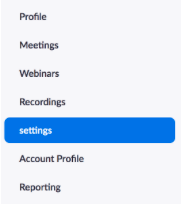Zoom video conferencing is a helpful teaching tool if students or staff are off campus. Here’s a basic guide to getting ready to Zoom – the UTS video conferencing platform that allows for one-on-one meetings, but also larger meetings with students and staff.
Get set…
Like every technology, Zoom has limitations, so follow some preparation steps prior to your online class to make sure everything runs smoothly. Here’s our basic guide, and remember the LX.lab is here to help you with Zoom, in person or online; head to www.lxlabservices.uts.edu.au.
Before your online class
- Read the basic set-up pages – instructions for setting up Zoom are available online for both Canvas and UTSOnline.
- Log in to your UTS Zoom account – Zoom is a supported tool at UTS, so all staff members have an account. Head to https://utsmeet.zoom.us/ and use your staff ID and password.
- Populate your profile – head to the top right corner and update your profile information. You should strengthen your online presence with students by including a profile picture.
- Test audio & video – Run some tests to make sure your microphone and camera are functioning properly. You can do this by moving your cursor to ‘Host a meeting’ in the top right corner of the Zoom screen and selecting the ‘with video on’ option. Zoom settings can be adjusted by going into the ‘settings’ tab on the left-hand side of the screen.

- Get your students ready – Communicate with your students about how you will be using Zoom for online classes. They should go through the same steps to test Zoom prior to the class and make sure their audio-visual settings are functioning.
- Make sure that everyone has access to the Meeting ID – Once the ‘meeting’ is created by the host, you will be able to send a meeting invitation to students by email, a Canvas or UTSOnline announcement, or your usual communication channel. This invitation contains the meeting ID that will be used to join the online class.
- Set up a quiet space – In a large class conference in Zoom, external noises can affect the audio quality of other users. A quiet space at home with a desk will be ideal. We also recommend using an external microphone and headphones if possible to improve the sound quality.
- Read the recording policy – you’ll notice below that recording your session is a feature of Zoom. Before you get started, make sure you understand your obligations as a meeting host by referring to the UTS recording policy.
During your online class
- Look for a chat monitor – Depending on your class size, it might be a good idea to ask a colleague to monitor Zoom’s chat thread during class, in case students ask technical questions about Zoom or experience any issues. If you don’t have any colleagues that can help, please lodge a ticket to the LX.lab team.
- Record your class – Zoom provides the option to record the class. This ensures you have a video of the class to share with students who couldn’t make the live session and to use later to revise content. Note: Local recording is not supported on mobile devices (iPhones or Android); see cloud recording for paid accounts if you are using a mobile device, or use a desktop computer or laptop.
- Accessing your recordings – At UTS, your recordings are automatically saved to Cloudstor, an Australian-based cloud recording service. Your recording will be processed and Zoom will send you (the host) an email from CloudStor with a link to recording and password to access/download it. Please allow up to 24 hours for processing for very long recordings. Once you have downloaded your recording, you are able to upload the file to Canvas or Blackboard to share with your students.
After your online class
- Download your recording to your computer so that you can then share it via Kaltura in Canvas and in UTSOnline, or directly via Microsoft Teams.
- It’s a good idea to check if students experienced any technical issues during the class so that you can follow up and can supply any information they may have missed for technical reasons.
Here are some handy tips from some UTS academics who are already using Zoom:
Join us via Zoom on Wednesday 18th March for this short online introduction to setting up and using Zoom for presenting lectures and hosting live collaborative discussions:
To get some extra assistance with using Zoom, swing by the LX.lab between 10am and 4pm and a Learning Designer will help you run audio/video tests and make sure you are ready to deliver an online class.
